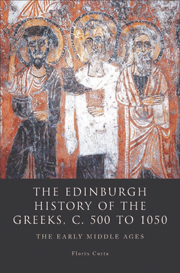Book contents
- Frontmatter
- Contents
- List of Illustrations
- List of Tables
- Acknowledgements
- Series Editor's Preface
- Introduction
- 1 The last century of Roman power (c. 500 to c. 620): army, church, and countryside
- 2 Collapse or adaptation? The problem of the urban decline in late antique Greece
- 3 Invasion or inflation? Hoards and barbarians in sixth- and early seventh-century Greece
- 4 Dark-Age Greece (c. 620 to c. 800)
- 5 Revival and expansion (c. 800 to c. 900)
- 6 The beginning of prosperity (c. 900 to c. 1050)
- 7 Early medieval Greece and the Middle Byzantine economy
- 8 Social structures and Byzantine administration in early medieval Greece
- 9 Christianity in early medieval Greece
- 10 Conclusion: the people of early medieval Greece
- Bibliography
- Index
1 - The last century of Roman power (c. 500 to c. 620): army, church, and countryside
Published online by Cambridge University Press: 05 August 2013
- Frontmatter
- Contents
- List of Illustrations
- List of Tables
- Acknowledgements
- Series Editor's Preface
- Introduction
- 1 The last century of Roman power (c. 500 to c. 620): army, church, and countryside
- 2 Collapse or adaptation? The problem of the urban decline in late antique Greece
- 3 Invasion or inflation? Hoards and barbarians in sixth- and early seventh-century Greece
- 4 Dark-Age Greece (c. 620 to c. 800)
- 5 Revival and expansion (c. 800 to c. 900)
- 6 The beginning of prosperity (c. 900 to c. 1050)
- 7 Early medieval Greece and the Middle Byzantine economy
- 8 Social structures and Byzantine administration in early medieval Greece
- 9 Christianity in early medieval Greece
- 10 Conclusion: the people of early medieval Greece
- Bibliography
- Index
Summary
‘The outpost at Thermopylae had from early times been under the care of the farmers of that region, and they used to take turns in guarding the wall there, whenever it was expected that some barbarians or other would make a descent upon Peloponnesus’ (Prokopios of Kaisareia, Secret History 26.31–4). So writes Prokopios of Kaisareia in one of the last chapters of his Secret History, a work written in direct response to Emperor Justinian's legislation and financial reforms initiated by the imperial agents in the provinces. At this point, Prokopios' bête noire is the discussor (logethetes) Alexander, nicknamed ‘Snips’ because of his ability to clip coins. In 540 or 541, Alexander apparently introduced a series of changes concerning the defence of Thermopylae, which, although not appearing in any surviving edict of Justinian, were apparently sufficiently outrageous to incriminate the regime:
But when Alexander visited the place on the occasion in question, he, pretending that he was acting in the interests of the Peloponnesians, refused to entrust the outpost there to the farmers. So he stationed troops there to the number of two thousand and ordained that their pay should not be provided from the imperial Treasury, but instead he transferred to the Treasury the entire civic funds and the funds for the spectacles of all the cities of Greece, on the pretext that these soldiers were to be maintained there from, and consequently in all Greece, and not least in Athens itself, no public building was restored nor could any other needful thing be done. Justinian, however, without any hesitation confi rmed these measures of ‘Snips’.
- Type
- Chapter
- Information
- The Edinburgh History of the Greeks, c. 500 to 1050The Early Middle Ages, pp. 13 - 47Publisher: Edinburgh University PressPrint publication year: 2011



